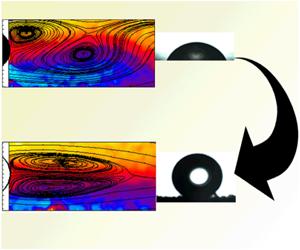当前位置:
X-MOL 学术
›
J. Fluid Mech.
›
论文详情
Our official English website, www.x-mol.net, welcomes your feedback! (Note: you will need to create a separate account there.)
Effect of superhydrophobicity on the flow past a circular cylinder in various flow regimes
Journal of Fluid Mechanics ( IF 3.7 ) Pub Date : 2020-06-15 , DOI: 10.1017/jfm.2020.371 P. Sooraj , Mallah Santosh Ramagya , Majid Hassan Khan , Atul Sharma , Amit Agrawal
Journal of Fluid Mechanics ( IF 3.7 ) Pub Date : 2020-06-15 , DOI: 10.1017/jfm.2020.371 P. Sooraj , Mallah Santosh Ramagya , Majid Hassan Khan , Atul Sharma , Amit Agrawal

|
The flow over a superhydrophobic and a smooth circular cylinder is investigated using particle image velocimetry-based experiments. The objective is to understand the effect of surface modification on the ensuing flow. The experiments are conducted over a wide range of Reynolds numbers, $Re=45{-}15\,500$ , thereby uncovering the effect of superhydrophobicity in various flow regimes of a cylinder wake. Superhydrophobicity is found to substantially affect the flow. An increased recirculation length is observed for the superhydrophobic cylinder in the steady regime. The onset of vortex shedding is delayed for the superhydrophobic cylinder. The superhydrophobic cylinder helps in an early rolling-up of vortices; therefore, the recirculation length reduces in unsteady regimes. The velocity deficit experienced by the superhydrophobic cylinder wake is comparatively less and the effect is more profound in the $Re$ range 300–860. A maximum drag reduction of 15 % is observed at $Re=860$ . The Reynolds shear stress and turbulent kinetic energy values are higher for the superhydrophobic cylinder in the unsteady regime. Also, the peaks of the turbulent wake parameters lie closer to the superhydrophobic cylinder compared to the smooth cylinder. The effect of superhydrophobicity on coherent structures is examined using proper orthogonal decomposition, and a considerable difference in the wake structure is noticed at $Re=860$ . A larger number of coherent structures and change in vortex shedding pattern to $\text{P}+\text{S}$ are observed in the near wake of the superhydrophobic cylinder. The results of this study show that surface modification can reduce the drag coefficient and have a profound effect on the near wake.
中文翻译:

超疏水性对不同流态下通过圆柱体的流动的影响
使用基于粒子图像测速法的实验研究了在超疏水和光滑圆柱体上的流动。目的是了解表面改性对随后流动的影响。实验是在大范围的雷诺数上进行的,$Re=45{-}15\,500$ ,从而揭示了超疏水性在圆柱尾流的各种流态中的影响。发现超疏水性显着影响流动。在稳定状态下观察到超疏水圆柱体的再循环长度增加。对于超疏水圆柱体,涡旋脱落的开始被延迟。超疏水圆柱体有助于涡旋的早期卷起;因此,再循环长度在不稳定状态下会减少。超疏水圆柱尾流所经历的速度缺陷相对较小,并且在 $Re$ 范围 300-860 内影响更为深远。在 $Re=860$ 处观察到最大减阻为 15%。在非定常状态下,超疏水圆柱体的雷诺剪切应力和湍流动能值更高。此外,与光滑圆柱体相比,湍流尾流参数的峰值更靠近超疏水圆柱体。使用适当的正交分解检查超疏水性对相干结构的影响,在 $Re=860$ 处注意到尾流结构的显着差异。在超疏水圆柱体的尾流附近观察到大量相干结构和涡旋脱落模式变化为 $\text{P}+\text{S}$。
更新日期:2020-06-15
中文翻译:

超疏水性对不同流态下通过圆柱体的流动的影响
使用基于粒子图像测速法的实验研究了在超疏水和光滑圆柱体上的流动。目的是了解表面改性对随后流动的影响。实验是在大范围的雷诺数上进行的,$Re=45{-}15\,500$ ,从而揭示了超疏水性在圆柱尾流的各种流态中的影响。发现超疏水性显着影响流动。在稳定状态下观察到超疏水圆柱体的再循环长度增加。对于超疏水圆柱体,涡旋脱落的开始被延迟。超疏水圆柱体有助于涡旋的早期卷起;因此,再循环长度在不稳定状态下会减少。超疏水圆柱尾流所经历的速度缺陷相对较小,并且在 $Re$ 范围 300-860 内影响更为深远。在 $Re=860$ 处观察到最大减阻为 15%。在非定常状态下,超疏水圆柱体的雷诺剪切应力和湍流动能值更高。此外,与光滑圆柱体相比,湍流尾流参数的峰值更靠近超疏水圆柱体。使用适当的正交分解检查超疏水性对相干结构的影响,在 $Re=860$ 处注意到尾流结构的显着差异。在超疏水圆柱体的尾流附近观察到大量相干结构和涡旋脱落模式变化为 $\text{P}+\text{S}$。



























 京公网安备 11010802027423号
京公网安备 11010802027423号